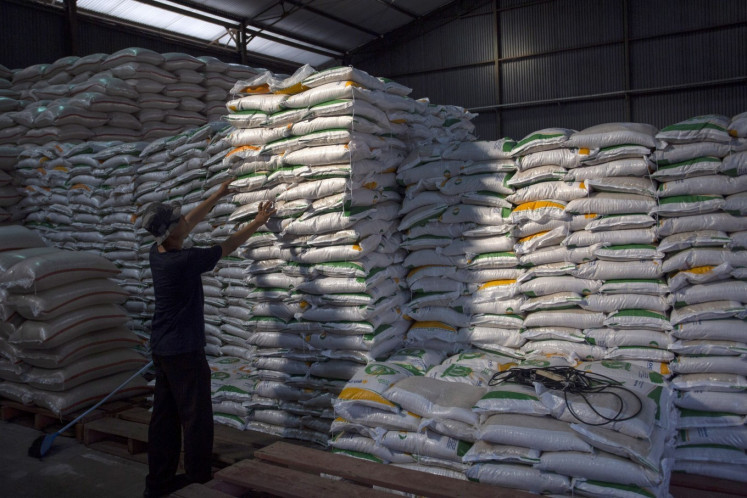Popular Reads
Top Results
Can't find what you're looking for?
View all search resultsPopular Reads
Top Results
Can't find what you're looking for?
View all search resultsCultivating food diversity
The nation's heavy dependence on rice as the primary staple food has triggered the need for food diversification, but up to now it is still a work in progress
Change text size
Gift Premium Articles
to Anyone
T
/span>The nation's heavy dependence on rice as the primary staple food has triggered the need for food diversification, but up to now it is still a work in progress.
If there is any food that deserves to be identified as the Asian food, it is rice ' people have it for breakfast, lunch and dinner.
'I always have rice,' said Ardi, a 39-year-old private company employee living in West Jakarta. 'If I don't have rice, I am still hungry.'
Rice is the staple food of more than 50 percent of the world's population, including in Indonesia where per capita rice consumption is estimated at 139 kilograms per year.
But the love affair with rice may not end up happily ever after. Out there, picture-perfect green rice fields are vanishing.
The latest report by the Indonesian Biodiversity Foundation (Kehati) has disclosed that agricultural land has drastically diminished across the archipelago, with up to 100,000 hectares of rice fields being converted to make way for industrial and other purposes each year.
This reality makes the efforts to push for food diversity crucial, not only to preserve local food heritage but also to improve people's quality of life and restore the country's food self-sufficiency.
The opportunity is there. The Food and Agricultural Organization (FAO) disclosed there are roughly a quarter of a million plant varieties available for agriculture but less than 3 percent is in use today.
Sri Sulihanti, head of the consumption diversification and food safety center at the Agriculture Ministry's Food Security and Education Agency, said the government had been aware of the need for food diversity since the 1960s and had pursued several approaches to make it happen.
She said various stakeholders, from officials, activists to communities, had been mobilized to engage in community programs aimed at maintaining and developing food diversification.
'Since 2009, there has been a growth in local food diversification,' Sri said.
In order to foster food diversification and security at the household level, Sri and her team currently implements the so-called Sustainable Food Homes program across the country by encouraging people to use their yards at home to grow food for the family.
If properly managed, the grown food could provide additional income, she added.
For homes with limited space, verticulture gardening ' a vertical planting system that cultivates crops in pots stacked on wall racks or hung from ceilings and roofs ' is effective for growing local produce, such as chilies, lettuce and bitter gourds.
'Until today, the program has been adopted in some 5,000 villages across the country,' Sri said.
The Slow Food movement, an ardent supporter of safeguarding food biodiversity all over the world, has joined forces ' supporting local food for local consumption.
'We attract people who are passionate about food and actually want to be able to have a food choice,' said Elena Anière, Slow Food program director for Asia and Oceania.
Most of today's consumers just buy what they want, pay and put questions ' like how fresh the food is, how clean or whether it is chemical-free ' to the back of their mind.
'Many times, we don't have food choices because there's no transparency in food. Slow Food is committed to actually providing alternatives to people and to making those alternatives easier and more accessible,' Anière said.
Slow Food, she said, also worked to boost the local economy by working with local farmers and educating consumers to sustain their local food culture in comparison to industrial food.
The group recently held a workshop at Kehati in Jakarta and invited officials from different government agencies as well as food communities, such as Indonesia Berkebun and Indonesia Berseru.
'We want to promote the Slow Food principles of good, clean and fair food gardens,' said Helianti Hilman, leader of Slow Food Convivium Kemang.
In Jakarta, the group plans to join forces with existing food garden initiatives as well as offering expert trainers in urban gardening, handing out rare crop seeds to food gardeners and collaborating with the city administration to transform idle land into food gardens.
Anière said the group was putting local biodiversity into the equation ' what foods are actually meant to be grown in the area and what have been grown there ' for the food garden, while reintroducing a local diet to people.
Puji Sumedi Hanggarawati of Kehati, who is also a Slow Food member, hopes the efforts will help local food producers prosper.
'We also hope our younger generations can be proud of the country's rich food biodiversity by always endorsing, consuming and conserving local foods.'










